![]()
![]()
![]()
Use LEFT and RIGHT arrow keys to navigate between flashcards;
Use UP and DOWN arrow keys to flip the card;
H to show hint;
A reads text to speech;
79 Cards in this Set
- Front
- Back
- 3rd side (hint)
|
Orientalizing Period |
- About 700-600 BC - Eastern influence came in - Early pieces came from Crete - In east the men were clothed, women were naked - Ivory was an eastern material, began to be used - Crete drops out |
|
|
|
Archaic Period |
- 600-480 BC - Archaic smile - More realistic looking - No snail curls - Lips slightly pressed into face, chin and cheekbones respond to it - Pupils slightly bulging, thin eyelids - Musculature is more pronounced |
|
|
|
Reasons for Archaic Style’s end |
- Style became “tired” (Kouros becoming more humanlike and foundry vases are created) - Greater confidence / command of subject |
|
|
|
Severe Style / Early Classical Period |
- 480 - 450 |
|
|
|
High Classical Period |
- 450 - 400 BC |
|
|
|
What is marble? |
- It's like limestone but subjected to more heat and pressure - Transportation was expensive - It can be melted in a limekiln and used for stucco |
|
|
|
Functions of Sculptures |
- Funerary - Honorary - Votive - Sculptures were religious until the Hellenistic Period (used as votive offerings) |
|
|
|
Temple uses |
- Weren't made for worship - Statues made them sacred |
|
|
|
Statue basics |
- Gods are larger than life - Gods have accessories / attributes - Humans had to be smaller than life size - 3-Time Olympians could be shown in action |
|
|
|
What art form came first? |
- Vase painting - 10 years later: relief sculpture - Last: free-standing sculpture |
|
|
|
Ethos |
- Inner character - Translated to the surface of a painting |
|
|
|
-isms |
- Idealism - Naturalism - Realism |
|
|
|
Idealism |
- Perfectly young and beautiful - Not necessarily realistic |
|
|
|
Naturalism |
- Recognizable but not photographic - Ex. of naked Donald Trump Statue |
|
|
|
Realism |
- As close to real as it can be / look |
|
|
|
How to identify pieces |
- Inscriptions - Attributes - Iconography |
|
|
|
Kouros |
- Left leg always forward - Arms usually down at sides and holding a "rod" - Naturalistic (never realistic) - Always nude - Very stylized bodies and hair |
|
|
|
Myron |
- He was one of the 3 greatest sculptors during the Early Classical Period - His sculptures created "rythmas" (movement) |
|
|
|
Polykleitos |
- Known for the perfect male nude athlete - One of the 3 greatest sculptors during the Early Classical Period |
|
|
|
Pheidias |
- One of the 3 greatest sculptors during the Early Classical Period |
|
|
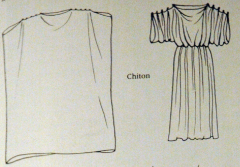
|
- Chiton - Buttoned along the top except for hole forhead - Cinched around the waist |
|
|
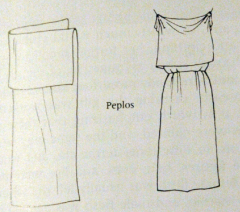
|
- Peplos - Folded over on top, held together on the side - Cinched around the waist |
|
|
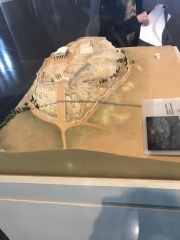
|
- Architectural sculpture - Archaic - Triangular shaped structures - Land = rock = problem - Buildings can be dated by coins / pottery that fall into the foundations |
|
|
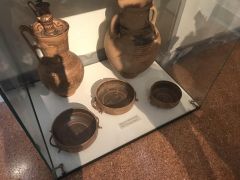
|
- 760 - 750 BC (Geometric) - Geometric articles - One was buried in a grave - a gift |
|
|

Front (Term)
|
- Dipylon ivory - 730 BC |
|
|
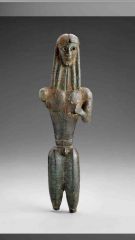
Front (Term)
|
- Mantiklos' Apollo - 700-675 BC - Inscription: Gives it as offering to Apollo, asks for something in return |
|
|
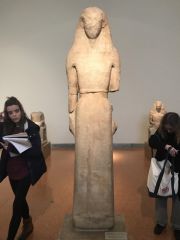
|
- Nikandre ("Victory over man") - 650 BC (Daedalic) - Important inscription on skirt - Naxion marble - Votive offering - Over life size = goddess - Held attributes |
|
|
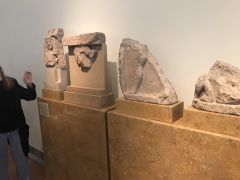
|
- Misenion / Triglyph medope - 620 BC (Daedalic) - Woman in the window motif - Normally cape would be hiding face but it's put down so face can be shown in art |
|
|
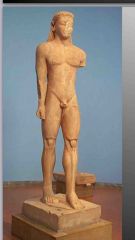
|
- Sounion Kouros - 600-580 BC (Archaic) - Not Daedalic, hair behind shoulders - Votive offering - Would have had a 3-tier base - Lost inscription |
|
|
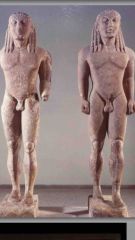
|
- Kleobis and Biton - 580 BC - Dedicated to Apollo at Delphi for their good deed in life |
|
|
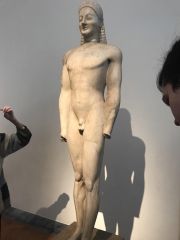
|
- Volomandra Kouros - 570 BC (Archaic) - Names after place it was found - Looks more naturalistic - Archaic smile |
|
|
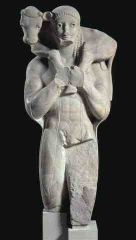
|
- Calf-bearer or Moskophoros - 560 BC - Votive |
|
|

|
- About 550 BC - Would've been on a treasury / iconic building - Heracles in the center - Hydra = swamp / water monster with 100 heads - To defeat her: Heracles hits heads off with a club and his friend cauterizes them so they can't grow back |
|
|

|
- The pediment of the Apotheosis - About 550 BC - Seated deity in the center: Zeus - Heracles wearing lion skin hat |
|
|
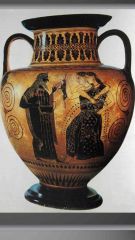
Front (Term)
|
- Amassis Painter or Vase of Maenads and Dionysus - 550 BC - Attempts to show two people with arms around each other like Dermys and Kitylos |
|
|

Front (Term)
|
- Melos Kouros - 550 BC
- Naxion marble - 7 feet tall - Funerary - Slender body, archaic smile, snail curls |
|
|
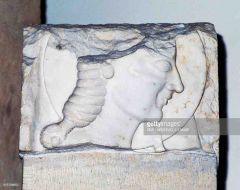
Front (Term)
|
- Diskophoros stele - 550 BC - Name means disk carrier - Archaic smile, frontal eye - Part of a larger gravestone - Used as a filler for the Themistoclean (?) wall |
|
|
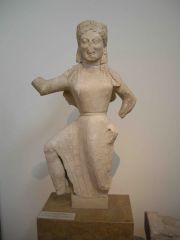
|
- Archermos' Nike - About 550 BC - From Delos - Knielauf: running with a bended knee - Crown of bronze - Traces of wings, could also be Artemis but Artemis typically isn't winged and running at the same time |
|
|
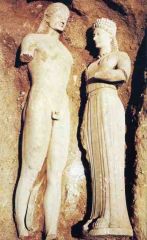
|
- Phrasikleia and her brother - Haven't been officially dated but after 550 BC based on knees/torso - Different sculptors but found buried together - Buried to protect them from the Persians - Funerary - Phrasikleia's base already in the museum before they were found - She is dressed elaborately as if for a wedding, married to Hades |
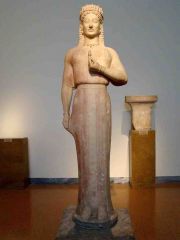
|
|

|
- Lyon Kore - 550-540 BC (AM date) - Upper part is a cast, original is in the Louvre - She isn't a karyatid - Butt is very masculine, breasts are an odd size and shape - Holding a bird offering and wearing a cap with palmettes |
|
|
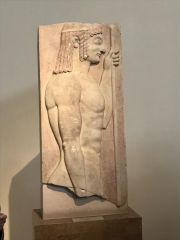
|
- NM Grave Stele - 550 - 540 BC - Very Archaic - Big eye - Slight smile - Ringlet hair |
|
|
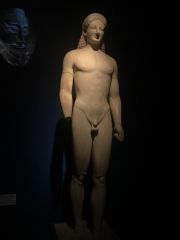
|
- Brother from Brother and Sister pair - Around 540 BC - Archaic smile - Round curls framing face - Flat forehead |
|
|
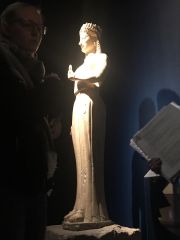
|
- Sister from Brother and Sister pair - Phrasikleia - Around 540 BC
- Dressed up as if for a wedding (dress was painted with details) - Wore a crown of closed lotus blossoms (symbol of death?)
|
|
|
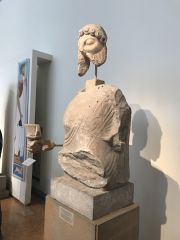
|
- Oversize statue of Dionysus - 540 - 530 BC - Argued that pieces don't go together - Back of head is flat which points to as mask |
|
|
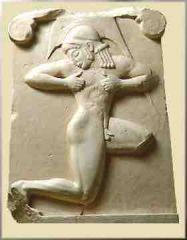
|
- Hoplite Runner Stele - 500 BC (NM), 540-530 BC (Anne) |
|
|
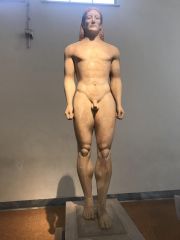
|
- Kroisos (after eastern king of Lidias) or Anavissos Kouros (after where he was found) - 530 BC (Archaic) - Attic trait: big / bulky butts and small waist - Excavated illegally and broken - More natural belly button - No poles in hands - Wearing a cap for unknown reason - Unmarried when he died because shown as a young kouros - Funerary: inscription tells you to stop and mourn at soldier's tomb and that he died in battle |
|
|
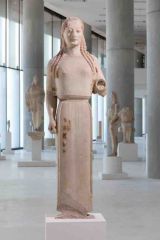
|
- Peplos Kore - 530 BC (Archaic) - Wearing a chiton underneath, a wreath and earrings - Archaic: protruding chin, bulging eyes, smile, high cheekbones - Line of animals painted down skirt |
|
|

|
- Kore 682, students call her the cat-eye Kore - 530 BC (AM date) - Has a bronze piece in her head that would have been used to hold mniskos/umbrella |
|
|

|
- Aristocles' Aristion - 530 BC - Grave stele - Wearing breast plate, chiton, shin guards, and abbreviated helmet - Bare feet = subtle way to heronize |
|
|

Front (Term)
|
- Antenor Kore - 530-520 BC - Sculpted by Antenor who was patronized by the Alkmaionids |
|
|
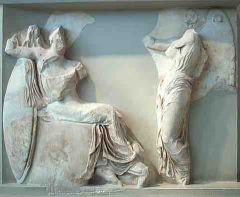
Front (Term)
|
- Seated Athena - 520-510 BC - Found on north side of the Acropolis, survived Persian burning - Wearing an aegis and chiton - May have been made by Endoios |
|
|
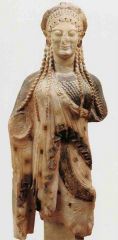
|
- Chiote Kore - 510 (AM) or even closer to 525-520 BC (Anne) - Archaic - Beautiful hair, bulging eyes, thin eyelids - Similar to the Nike in the NM, father probably carved Nike and son carved Kore |
|
|
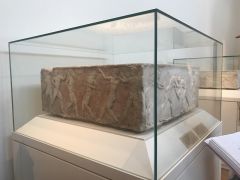
|
- Ballplayers base - 510 BC (Archaic) - In low relief carved into the back of a stele - Trying to work out movement - Attempting to foreshorten - Sculptors practiced on reliefs |

|
|

|
- Dismantled pediments - Dismantled around 510 BC (Archaic) - Pieces are still being found - Lots of paint left - lasts longer on limestone than on marble - Dismantled during transition from tyranny to democracy |
|
|
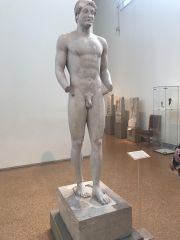
|
- Aristodikos - 510 BC (Late Archaic) - Transitioning into Early Classical style - Funerary - Short hair, sumptuary laws made everyone equal under the law and long hair was a sign of wealth - Arms are moved out and have struts for support - Wearing penis ring for unknown reason |
|
|
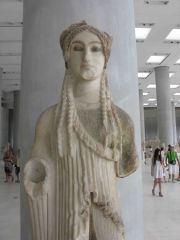
Front (Term)
|
- La Delicata or Kore with "Almond-Shaped Eyes" - 510 or even closer to 500 BC - Softer face, more feminine - Drapery is less elaborate - Not smiling, recessed eyes, thicker eyelids - Still Archaic though |
|
|
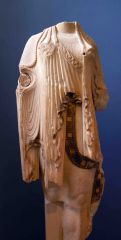
|
- Kore 594 - 500 BC - Classic example of how most korai wear their chiton and himation - Butt and legs are still fairly masculine but would have been up against a wall |
|
|
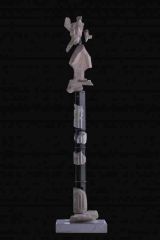
Front (Term)
|
- Nike atop a column - 490 BC - Dedicated for someone's son who died - Less extreme knielauf - Experienced sculptor, drapery broke on the bias which matches the sculpted line instead of being horizontal |
|
|
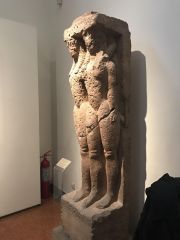
|
- Dermes and Kitylos - Hard to date but Daedalic, late 6th or early 5th century - Artist didn't know how to carve arms around the shoulders - Not kouroi |
|
|
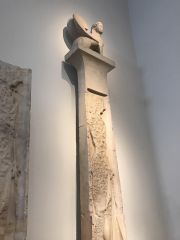
|
- Kerameikos-Dibpalon cemetery - Used for fill in Themistoclean wall in 480 BC - Front chopped off to be hidden in the ground from the Persians - Medusa in knielauf position (bend in knee / running) - Sphinx on top |
|
|
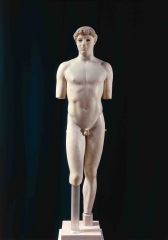
|
- Kritios boy - 480 BC - Right leg coming forward, hips respond - Hair is long but wrapped around head |
|
|
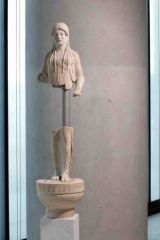
|
- Euthydikos Kore - 480 BC - Euthydikos dedicated it - Mouth is a pout, heavy jaw, becoming more simplified as Classical period draws nearer - Legs don't seem to match torso |
|
|
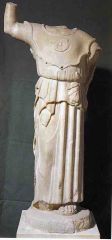
|
- Angelitos Athena - 480 BC - Chitón drops out of Athena's iconography in 480 and later sculptures show her wearing a peplos with a blouse underneath |
|
|
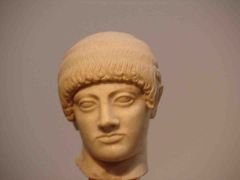
Front (Term)
|
- Blond boy - 480 BC |
|
|

Front (Term)
|
- Riacci A - 470 BC - Found on the ocean floor, but not part of a shipwreck |
|
|
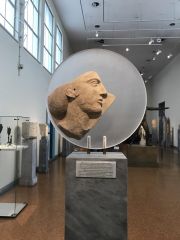
|
- Melos Disc - 470 - 460 BC - Purpose unknown: only circular piece until the roman period - Eye moving from frontal to profile - Votive offering - Could be Aphrodite |
|
|
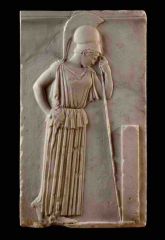
Front (Term) |
- Pensive or Mourning Athena - 470-460 BC - Severe style - Hair and drapery painted, helmet tipped back, wearing a peplos |
|
|

Front (Term) |
- West pediment of the temple of Temple of Zeus at Olympia - 470-457 BC - Dynamic figures, centaurs kidnapping women |
|
|
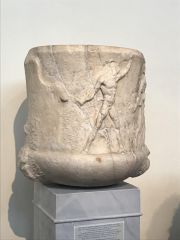
|
- Unfinished crater, Roman copy - 460 - 450 BC - Original ould've been done by Myron - This shows first stage of a myth that is continued on two other pieces |
|
|
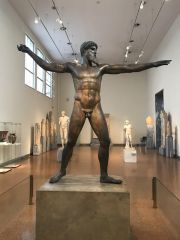
|
- Zeus, not Posiden (because trident doesn't fit the scenario/his hand and lightnight bolt does) - 450 BC - On edge of Severe Style and High Classical - Arms out in bronze like marble couldn't do until much later - Inlaid eyes, silver eyelashes - Arms are long |
|
|
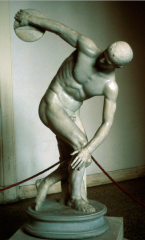
|
- Diskobolos by Myron - 450 – 440 - Myron’s favorite piece - Originally made in bronze - Body makes eye move around the piece |
|
|
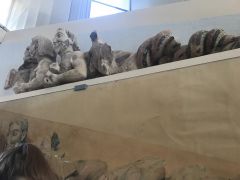
|
- All have attributes (bird, water, grain / torch) - Beards look like they're from the east - One set of wings for all three of them - Bird represents the people of the mountains |
|
|
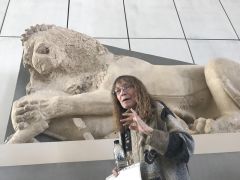
|
- Another pediment - Missing other lion and bull - A lot of reconstruction - Gender? Has a mane and teets |
|
|
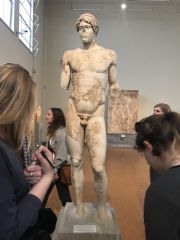
|
- Omphalos (?) - Very good Roman copy (no need for stability behind leg) - Omphalos means belly button and its a type of stone: refers to myth of Kronos eating children until he's tricked into eating a stone - Every man strove to have a "perfect" body like Apollo, so they sculpted them too |
|
|
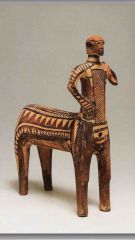
Front (Term) |
- Leukandi centaur - 900-850 BC - Centaurs originally depicted with human front legs - Single gash in front leg to indicate it is Cheiron (the good centaur) |
|
|
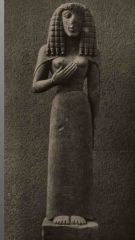
Front (Term) |
- Auxerre Kore - 640 BC - Proportions make her look taller, only .65 m tall |
|
|
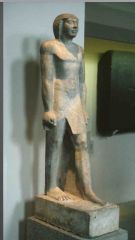
Front (Term) |
- Egyptian statue - 2800 BC - Sculpted on a grid |
|
|
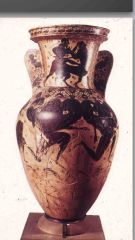
Front (Term) |
- Heracles and Netos - 650-640 BC |
|
|
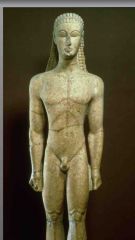
Front (Term) |
- New York Kouros - 600-580 BC - Only known Kouros sculpted on Egyptian grid - From the same workshop as the Sounion Kouros |
|

